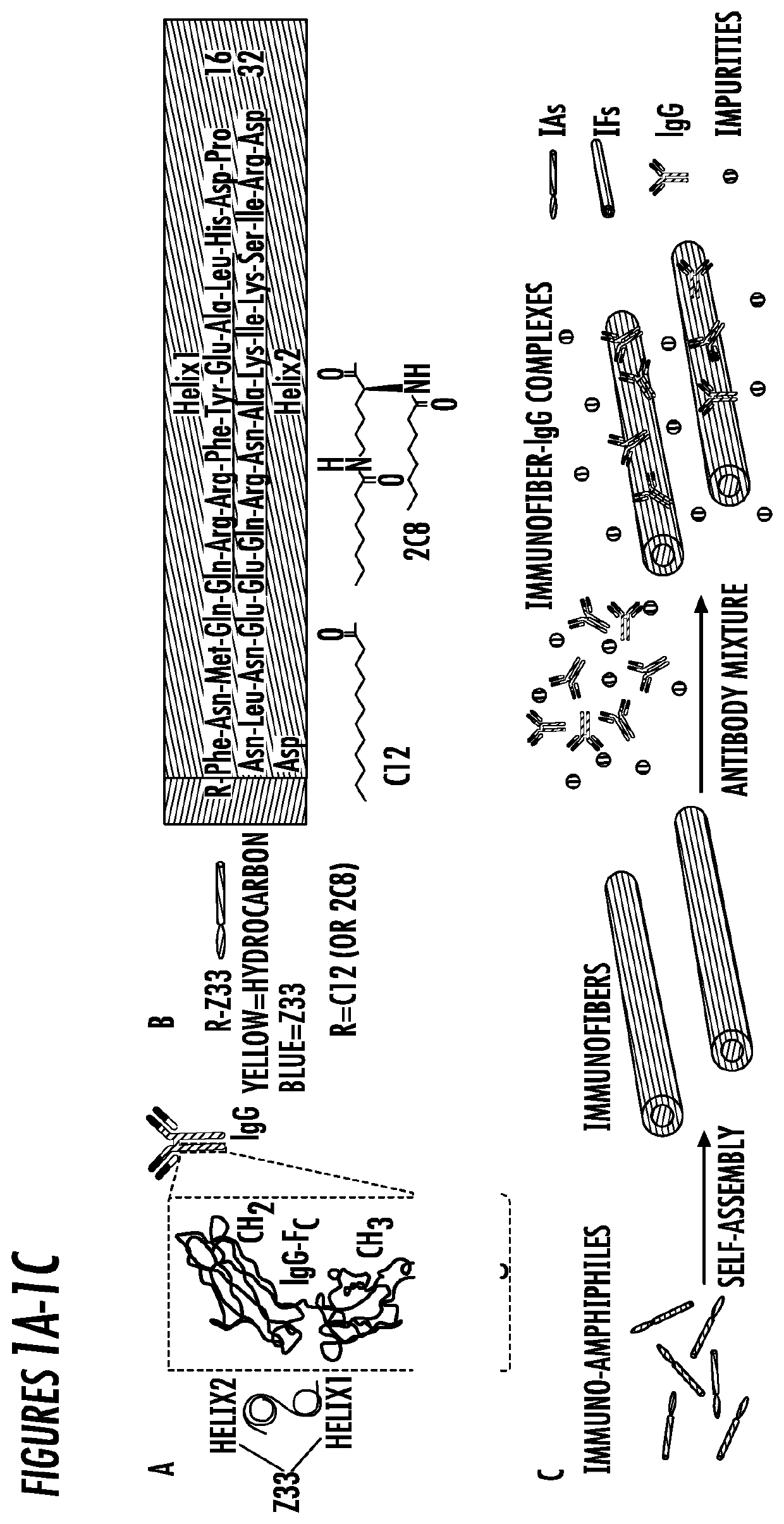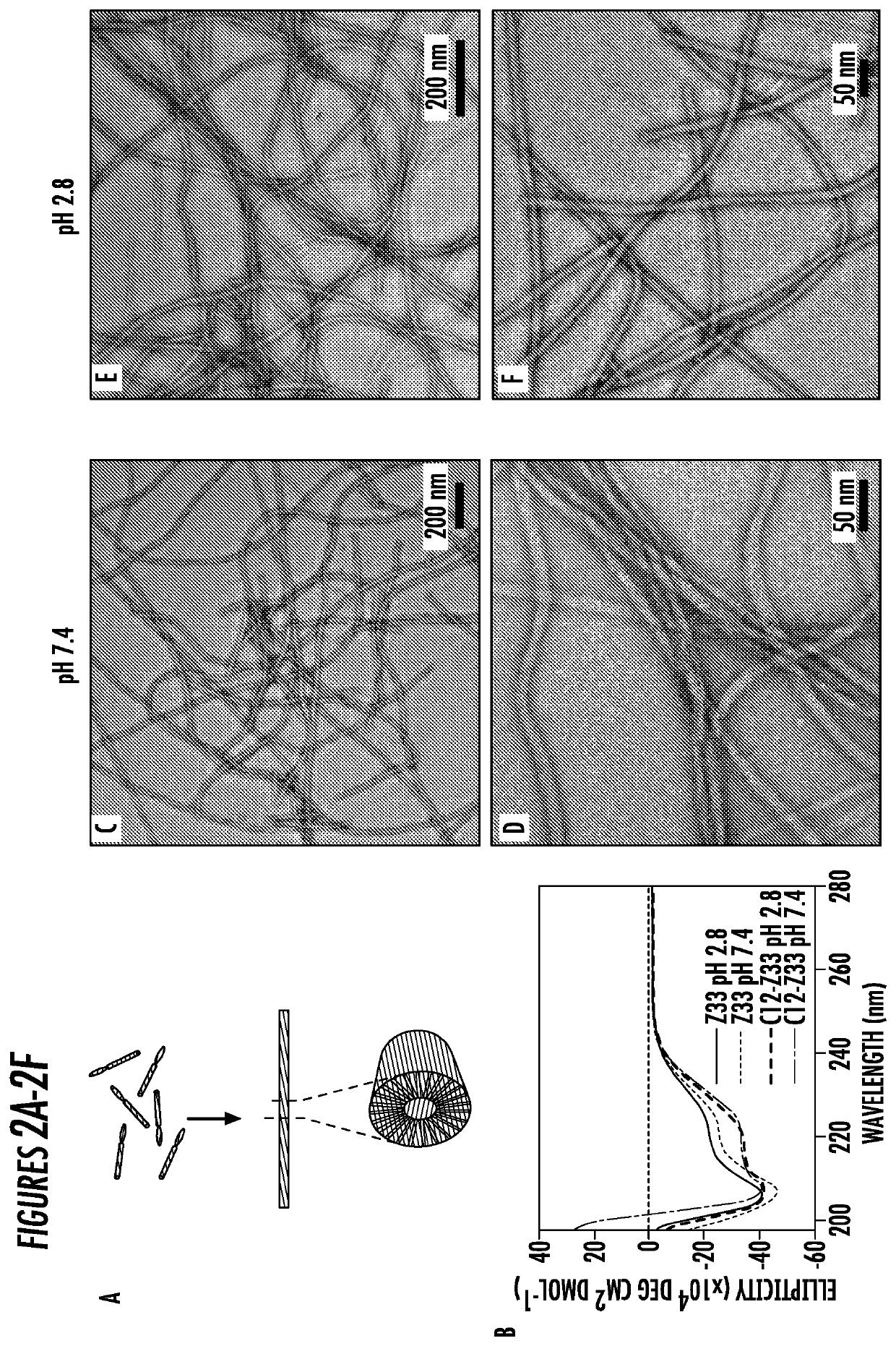Supramolecular high affinity protein-binding system for purification of biomacromolecules
a high affinity protein and purification technology, applied in the field of supramolecular high affinity protein-binding system for purification of biomolecular components, can solve problems such as incompatibility of spacing, and achieve the effect of promoting directional, anisotropic growth of resultant assemblies
- Summary
- Abstract
- Description
- Claims
- Application Information
AI Technical Summary
Benefits of technology
Problems solved by technology
Method used
Image
Examples
example 1
[0067]Molecular Design of full length Z33 immuno-amphiphiles. The construction of this amphiphilic peptide conjugates such as peptide amphiphiles, peptide-polymer conjugates, peptide-drug conjugates, etc., has been widely used to create a variety of supramolecular nanostructures. IgG binding immuno-amphiphiles consisting of hydrophilic Z33 peptide sequence (FNMQQQRRFYEALHDPNLNEEQRNAKIKSIRDD) (SEQ ID NO: 1) and hydrophobic alkyl chains were designed to serve as the building motifs for immunofibers (IFs). Z33 peptide is a two-helix derivative from protein A (FIG. 1A) that specifically binds to the Fc portion of IgG with high binding affinity (Kd=43 nM).28, 41-42
[0068]Two IAs, C12-Z33 and 2C8-Z33 (FIG. 1B), were synthesized via directly conjugating a lauric acid moiety (C12), or two octanoic acid moieties (2C8), onto the N-terminus of Z33 peptide. As is shown in FIG. 1C, the IAs were expected to self-assemble into IFs and specifically bind to IgG from the antibody mixture solution. Pu...
example 2
[0069]Molecular Self-Assembly and Characterization of full length Z33 immuno-amphiphile embodiments. The self-assembly of two IAs can be easily achieved through a two-step operation. First, the IAs were pretreated in hexafluoroisopropanol (HFIP) separately to eliminate any pre-existing nanostructures that may affect its solubility and the uniformity of the self-assembled morphologies. Second, HFIP was removed via evaporation, followed by subsequent addition of deionized water or phosphate-buffered saline (PBS) to reach a final concentration of 1 mM. The IFs formed with alkyl segment trapped in the core of the IFs by hydrophobic interactions and the bioactive Z33 sequence displayed in the shell facing towards the solvent (FIG. 2A). After aging overnight at room temperature, transmission electron microscopy (TEM) and circular dichroism (CD) were utilized to characterize the morphology of the assembled nanostructures.
[0070]Given the vital role of pH conditions in the inventive IgG puri...
example 3
[0071]ITC Experiment for Measuring Binding Affinity of IFs. Given the conformation change in the secondary structure of Z33 peptide after incorporation into IFs, it is of great interest to know if the formation of C12-Z33 IFs would influence the IgG binding ability existing in original Z33 peptide. To investigate the binding affinity of the self-assembled C12-Z33 IFs, thermodynamic properties of the binding to IgG1 were investigated by isothermal titration calorimetry (ITC). ITC has been widely employed to monitor the binding events between great numbers of proteins and ligands,43-45 which is an excellent method to explore if the binding could occur between C12-Z33 IFs and IgG1.46-47 The heat that is associated with the binding reaction was recorded during the stepwise injections and the thermodynamic parameters including thermodynamic dissociation constant (Kd), molar enthalpy change (ΔH°), and stoichiometry (N), can be obtained directly.44
[0072]
TABLE 1Thermodynamic parameters for ...
PUM
| Property | Measurement | Unit |
|---|---|---|
| pH | aaaaa | aaaaa |
| flow rate | aaaaa | aaaaa |
| path length | aaaaa | aaaaa |
Abstract
Description
Claims
Application Information
 Login to View More
Login to View More - R&D
- Intellectual Property
- Life Sciences
- Materials
- Tech Scout
- Unparalleled Data Quality
- Higher Quality Content
- 60% Fewer Hallucinations
Browse by: Latest US Patents, China's latest patents, Technical Efficacy Thesaurus, Application Domain, Technology Topic, Popular Technical Reports.
© 2025 PatSnap. All rights reserved.Legal|Privacy policy|Modern Slavery Act Transparency Statement|Sitemap|About US| Contact US: help@patsnap.com



